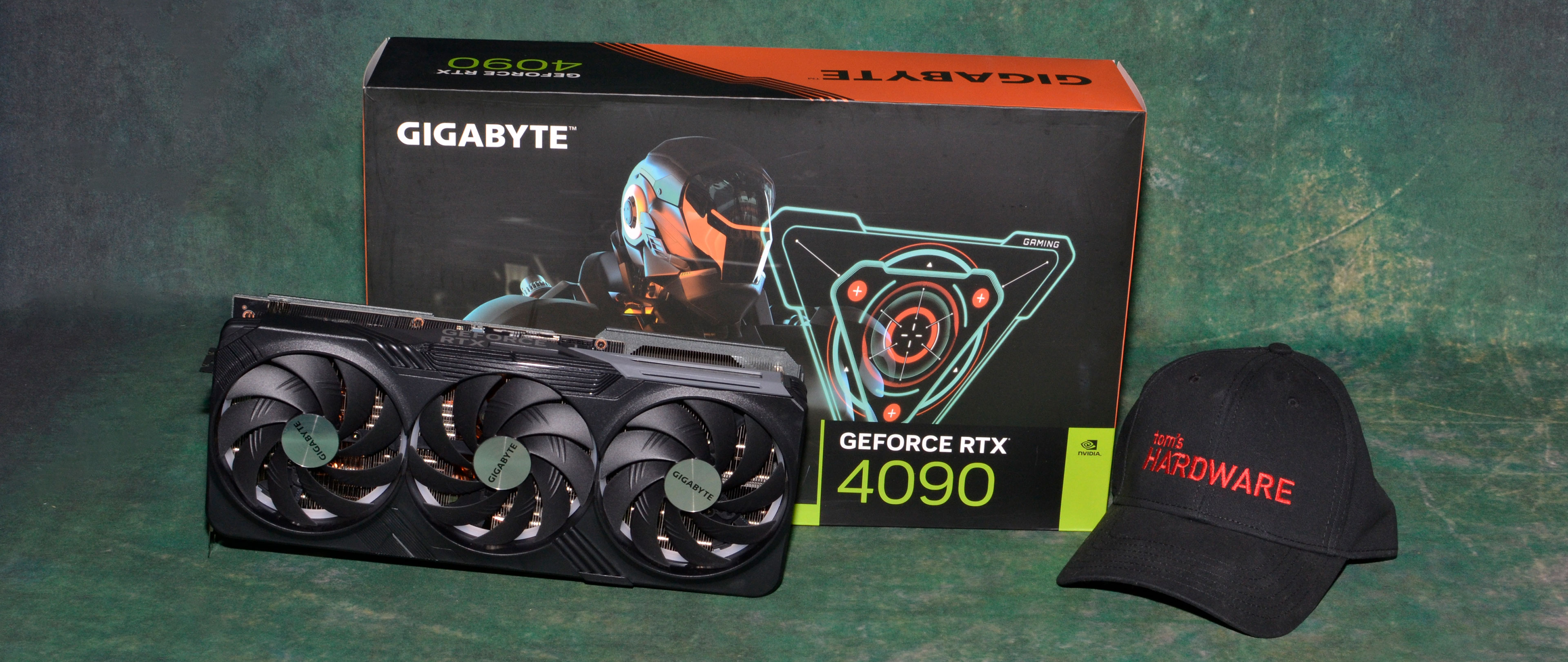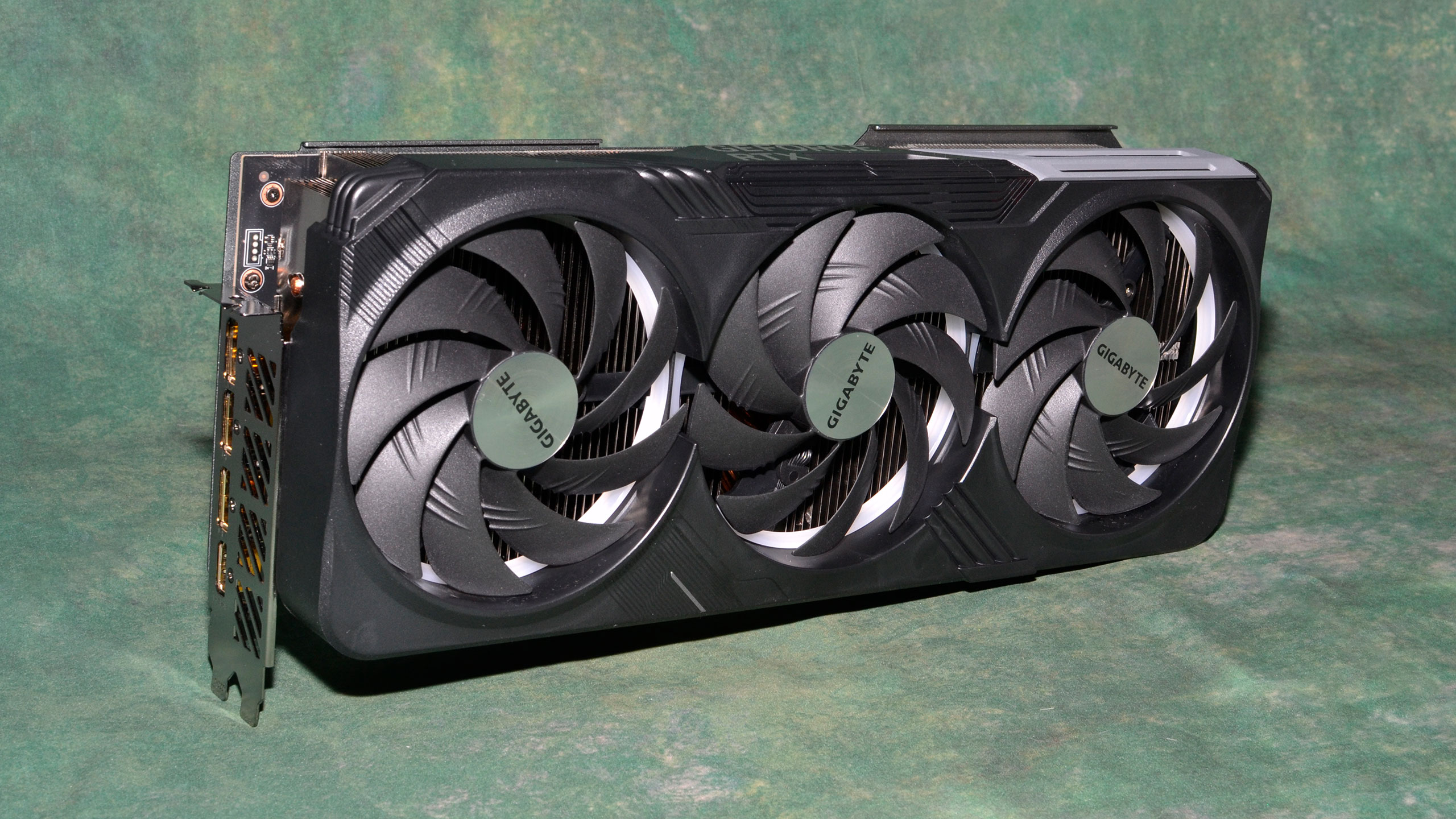Tom's Hardware Verdict
Gigabyte’s RTX 4090 performs nearly as well as other cards using the same GPU, though the paltry factory overclock barely warrants mention. Buy it for the aesthetics or price more than any extras.
Pros
- +
Generally matches other 4090 cards
- +
Includes a support bracket if you need it
- +
Plenty of RGB lighting
Cons
- -
Not faster than 4090 Founders Edition
- -
Default RGB lighting mode isn’t great
- -
Needs a large case
- -
3-slot card with a 2-slot IO bracket
Why you can trust Tom's Hardware
The Gigabyte RTX 4090 Gaming OC is our fourth RTX 4090 card review. You can check out the Nvidia RTX 4090 Founders Edition, Asus RTX 4090 ROG Strix OC, and MSI RTX 4090 Suprim Liquid X for details on the other three cards, though performance results will be included in our charts. As the top performer in our GPU benchmarks hierarchy and one of the best graphics cards, plenty of people are looking at Nvidia’s halo RTX 4090 GPU and the various card models that use it, so let’s see how Gigabyte’s model stacks up.
Gigabyte’s Gaming OC represents one of the more traditional designs we’ve seen so far, and it’s ultimately no better or worse than the competition. A 1–2% difference in performance here or there falls within the margin of error on our benchmarks, which means the main draws of this card will be the looks, retail availability, and pricing. The core design appears to be identical to Gigabyte’s RTX 4090 Windforce, with the key difference being the RGB lighting rings around the fans — the 15 MHz factory overclock barely warrants a mention.
Let’s also address the gigantic melting 16-pin elephant in the corner. There’s still no official word on what’s causing the problems, but with over 20 melted connectors in just the past month — including a few that didn’t use the adapter cable and opted instead for a direct PSU connection — we can’t help but feel concerned. That goes for all 4090 cards at present, which means if you have one, you should exercise caution and regularly check temperatures, or perhaps just don’t actively use it right now. We really need a statement of findings from Nvidia at this stage, and until we get that it’s going to be a pain point for all RTX 40-series cards that use the 16-pin connector, including the upcoming RTX 4080.
| Graphics Card | Gigabyte RTX 4090 Gaming OC | Asus RTX 4090 ROG Strix OC | MSI RTX 4090 Suprim Liquid X | Nvidia RTX 4090 Founders Edition |
|---|---|---|---|---|
| Architecture | AD102 | AD102 | AD102 | AD102 |
| SMs | 128 | 128 | 128 | 128 |
| GPU Shaders | 16384 | 16384 | 16384 | 16384 |
| Boost Clock (MHz) | 2535 | 2640 (OC mode) | 2625 | 2520 |
| VRAM Speed (Gbps) | 21 | 21 | 21 | 21 |
| VRAM (GB) | 24 | 24 | 24 | 24 |
| TFLOPS FP32 (Boost) | 83.1 | 86.5 | 86 | 82.6 |
| TFLOPS FP16 (FP8) | 665 (1329) | 692 (1384) | 688 (1376) | 661 (1321) |
| Bandwidth (GBps) | 1008 | 1008 | 1008 | 1008 |
| TDP (watts) | 450 | 480 (OC mode) | 480 | 450 |
| Dimensions | 340x143x74mm | 358x149x70mm | Card: 280x139x42mm | 304x137x61mm |
| Radiator: 275x117x54mm | ||||
| Weight | 1990g | 2508g | 2336g | 2186g |
| Official MSRP | $1,699 | $1,999 | $1,749 | $1,599 |
On paper, the only real difference between the various RTX 4090 cards is their rated boost clocks and the resulting performance. In practice, the boost clocks are conservative, and we’ve found in testing that the four 4090s we’ve tested all run at 2.7–2.8 GHz while gaming. Best-case, then, we’re looking at around a 4% difference in performance, and in practice it’s usually less than 2%. That means you should focus on other factors, like aesthetics, any included extras, card size, and especially price — assuming you can find more than one of these cards in stock.
Gigabyte sets the boost clock for the Gaming OC at 2,535 MHz, a 0.6% overclock compared to the reference card. At stock settings, we saw average GPU clocks of 2,715–2,757 MHz across our test suite. That’s on the slightly slower end of the spectrum compared with the other 4090 GPUs we’ve tested, but only by around 20 MHz on average — not something you’d notice in the real world.
For more information on the core RTX 4090 functionality, check out our Nvidia Ada Lovelace architecture piece where we go into more detail about the various changes Nvidia has made relative to the previous generation Ampere architecture. There are also additional tests that we performed with the RTX 4090 Founders Edition, including professional content creation workloads and DLSS 3 testing. Our AIB card reviews focus more on the card design and aesthetics, as well as any other extras, as those tend to be more important than minor variations in performance.
- MORE: Best Graphics Cards
- MORE: GPU Benchmarks and Hierarchy
- MORE: All Graphics Content
Get Tom's Hardware's best news and in-depth reviews, straight to your inbox.
Current page: Gigabyte RTX 4090 Gaming OC Review
Next Page Gigabyte RTX 4090 Gaming OC: Design, Teardown, and Overclocking
Jarred Walton is a senior editor at Tom's Hardware focusing on everything GPU. He has been working as a tech journalist since 2004, writing for AnandTech, Maximum PC, and PC Gamer. From the first S3 Virge '3D decelerators' to today's GPUs, Jarred keeps up with all the latest graphics trends and is the one to ask about game performance.
-
cknobman Between pricing, power, things melting I want nothing to do with this gen of Nvidia cards.Reply
I'll wait to see what AMD has and if they suck too then I will just wait for next gen or pricing to drop like a rock. -
Roland Of Gilead Replycknobman said:Between pricing, power, things melting I want nothing to do with this gen of Nvidia cards.
I'll wait to see what AMD has and if they suck too then I will just wait for next gen or pricing to drop like a rock.
Have to agree with you! This chase for max performance is not something I'm interested in. Same with current gen CPU's. Too much power draw.
It's almost cyclical. A good few years ago, power requirements went up dramatically for both GPU's and CPU's, and then dialled back a little with more efficient designs. Seems like we're here again. Hopefully the next gen or two will dial back power consumption to more reasonable levels, while maintaining a decent leap in performance over the previous gen. Specially where we are right now in a global sense, cost of living, utilities, and an ever-worsening climate situation. Electricity/Gas costs a bomb here in Europe. These GPU's just don't make sense for most people. -
RodroX @JarredWaltonGPU with the melting adapter and native cables issues, you Sir are a very brave man to go ahead and OC one of this beasts!Reply -
mrv_co I guess I'm glad these cards exist and continue to push the performance envelope, but I just never made the mental leap to need or want a 'flagship' GPU (much less an even larger case and even more power hungry power supply)... especially since, having had full-tower and mid-tower cases over the years, I transitioned to a SFF case that is cool, quiet and fits neatly under my desk, while realizing that I'm perfectly happy with my ultra wide QHD display.Reply -
JarredWaltonGPU Reply
What's the worst that can happen? It's not like I leave the PC running and walk away for hours. If it melts, that would be sort of awesome and I could do an article on how I caused a 4090 to melt! LOLRodroX said:@JarredWaltonGPU with the melting adapter and native cables issues, you Sir are a very brave man to go ahead and OC one of this beasts!
I still suspect there's a better than reasonable chance Jonny Guru is right and that a few people didn't properly insert the connector. There's a lot of current running through there. Manufacturing defects are the only other real possibility. Given we never heard of people melting RTX 3090 or 3090 Ti 12-pin connections, and that the extra four sense pins make it a bit more difficult to fully insert the 16-pin connector, that seems the most likely option.
But until we have some official statement of cause and cure, it really muddies the RTX 40-series waters! -
junglist724 Reply
I've been sticking flagship CPUs and GPUs into SFF cases for a couple generations now. The 4090FE still fits into some SFF cases and should work well in ones that take good advantage of flow through coolers. The C4-SFX(if it ever actually releases) looks like it would work well even in an air cooled build with a 7950X/13900K + 4090FE. Use an SX1000 PSU plus a 90 or 180 degree 12VHPWR adapter and powering it should be fine.mrv_co said:I guess I'm glad these cards exist and continue to push the performance envelope, but I just never made the mental leap to need or want a 'flagship' GPU (much less an even larger case and even more power hungry power supply)... especially since, having had full-tower and mid-tower cases over the years, I transitioned to a SFF case that is cool, quiet and fits neatly under my desk, while realizing that I'm perfectly happy with my ultra wide QHD display. -
Neilbob Trying hard ... not ... to be ... grumpy old ... misery guts ... ack ...Reply
Subjective: Quantity and/or quality of RGB a matter of total irrelevance to some people.
Pained gasping for breath
(Has no intention of ever letting one of these near the electricity bills. Not sure why the need was felt to comment at all).

